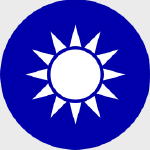Hobby Master HA4004 ROCAF AIDC F-CK-1A Ching-Kuo Indigenous Defense Fighter - "1433 / 84-8051", 427th Tactical Fighter Wing, Taiwan (1:72 Scale)
"Obsolete weapons do not deter."
- British Prime Minister Margaret Thatcher
 The AIDC F-CK-1 Ching-kuo, commonly known as the Indigenous Defence Fighter (IDF), is an air superiority jet fighter with multirole capability named after Chiang Ching-kuo, the late President of the Republic of China. The aircraft made its first flight in 1989.
The AIDC F-CK-1 Ching-kuo, commonly known as the Indigenous Defence Fighter (IDF), is an air superiority jet fighter with multirole capability named after Chiang Ching-kuo, the late President of the Republic of China. The aircraft made its first flight in 1989.
The IDF program was initiated when the United States of America refused to sell F-20 Tigershark and F-16 Fighting Falcon fighters to the Republic of China (Taiwan) following pressure on the United States from the People's Republic of China (PRC). The Republic of China therefore decided to develop an indigenous fighter. The IDF jet fighter project was designed and built by the Aerospace Industrial Development Corporation (AIDC) based in Taichung, Taiwan, with assistance from American defense corporations.
It entered active service with the Republic of China Air Force in 1994, and 130 production aircraft had been manufactured by 1999.
The preliminary search for a replacement for the Republic of China Air Force's F-5s and F-104s began with the XF-6 indigenous fighter project, later renamed Ying Yang, in the late 1970s. After the US established formal relations with the People's Republic of China and ended the Mutual Defense Treaty with Republic of China, President Chiang Ching-Kuo decided to expand the indigenous defense industry and on August 28th, 1980, ordered AIDC to design an indigenous interceptor. Originally, the ROCAF listed the priority of the XF-6 behind the XA-3 Lei Ming attack aircraft, due to the believed high risks of the XF-6 project.
The signing of the 1982 US-PRC Joint Communique, limited arms sales to the Republic of China. The United States refused to sell the General Dynamics F-16 Fighting Falcon and the Northrop F-20 Tigershark (which had been developed largely to meet Taiwanese needs for a follow-on to its F-5s, therefore ensuring the continuation of the indigenous fighter project. Although US President Ronald Reagan reluctantly accepted his advisers' suggestion of building relations with the People's Republic of China to counter the USSR, Reagan decided to balance the 1982 US-PRC Communique with the "Six Assurances" to Republic of China. This opened the door for US technology transfer and assistance to Republic of China's defense industry, including the IDF project.
Pictured here is a 1:72 scale replica of a ROCAF AIDC F-CK-1A Ching-Kuo Indigenous Defense Fighter that was attached to the 427th Tactical Fighter Wing, then deployed to Taiwan.
Sold Out!
Dimensions:
Wingspan: 7-inches
Length: 8-inches
Release Date: December 2011
Historical Account: "Throttle Up" - The greatest difficulties were encountered by the propulsion group in attempting to develop or acquire suitable advanced jet engines. There is also speculation that the use of less powerful engines was due to political rather than technical reasons, namely that the US did not want to see the Republic of China provoke the People's Republic of China and thus mandated the IDF to have a "range no greater than the F-5E" and "ground attack capability no greater than the F-16". Regardless of the reason, many people consider the original 1980's prototype F-CK-1 to be somewhat underpowered due to its original engines.
In April 1997, American company Litton's Applied Technology division was awarded a production contract and options totaling $116.2 million by the Aerospace Industrial Development Corporation for Improved Radar Warning Receivers (IRWR) to be installed aboard.








